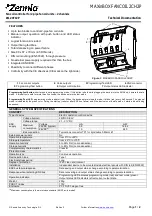
ST10 FAMILY PROGRAMMING MANUAL
37/172
2.6.8 - Addressing modes
Specifies available combinations of addressing
modes. The selected addressing mode combina-
tion is generally specified by the opcode of the
corresponding instruction.
However, there are some arithmetic and logical
instructions where the addressing mode combina-
tion is not specified by the (identical) opcodes but
by particular bits within the operand field.
In the individual instruction description, the
addressing mode is described in terms of mne-
monic, format and number of bytes.
– Mnemonic gives an example of which operands
the instruction will accept.
– Format specifies the format of the instruction as
used in the assembler listing.
Figure 3
shows
the reference between the instruction format
representation of the assembler and the corre-
sponding internal organization of the instruction
format (N = nibble = 4 bits). The following sym-
bols are used to describe the instruction for-
mats:
Table 26 : Instruction format symbols
00
h
through FF
h
Instruction Opcodes
0, 1
Constant Values
:....
Each of the 4 characters immediately following a colon represents a single bit
:..ii
2-bit short GPR address (Rw
i
)
ss
8-bit code segment number (seg).
:..##
2-bit immediate constant (#data
2
)
:.###
3-bit immediate constant (#data
3
)
c
4-bit condition code specification (cc)
n
4-bit short GPR address (Rw
n
or Rb
n
)
m
4-bit short GPR address (Rw
m
or Rb
m
)
q
4-bit position of the source bit within the word specified by QQ
z
4-bit position of the destination bit within the word specified by ZZ
#
4-bit immediate constant (#data
4
)
8-bit word address of the source bit (bitoff)
rr
8-bit relative target address word offset (rel)
RR
8-bit word address reg
ZZ
8-bit word address of the destination bit (bitoff)
##
8-bit immediate constant (#data
8
)
@@
8-bit immediate constant (#mask
8
)
pp 0:00pp
10-bit page address (#pag10)
MM MM
16-bit address (mem or caddr; low byte, high byte)
## ##
16-bit immediate constant (#data
16
; low byte, high byte)
Summary of Contents for ST10 Series
Page 2: ......















































